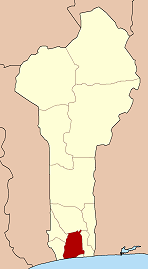Savi
Savi | |
|---|---|
Arrondissement and town | |
 | |
| Coordinates: 6°23′10″N 2°06′21″E / 6.3861°N 2.1058°E | |
| Country | |
| Department | Atlantique Department |
| Commune | Ouidah |
| Population (2002) | |
• Total | 6,949 |
| Time zone | UTC+1 (WAT) |
Savi is a town and arrondissement in the Atlantique Department of southern Benin. It is an administrative division under the jurisdiction of the commune of Ouidah. According to the population census conducted by the Institut National de la Statistique Benin on February 15, 2002, the arrondissement had a total population of 6949.[1] It was previously the capital of the Kingdom of Whydah.
History
[edit]

Savi was the capital of the Kingdom of Whydah prior to its capture by the forces of Dahomey in 1727.
An account of the city was given by Robert Norris in 1789:
Sabee, at that period the metropolis of the kingdom, the residence of their monarch, and seat of their commerce, was more than four miles in circumference. The houses, constructed with mud walls, were roofed with thatch. The factory houses of the European traders were spacious and airy, distributed into convenient apartments, and surrounded on the outside with a large gallery opening into balconies. The town swarmed with people, insomuch, that it was impossible to pass through the streets without great difficulty. Markets were held every day, at which were exposed to sale all sorts of merchandizes, European and African, besides abundance of provisions of every kind.[2][3]
There were British, French, Dutch and Portuguese factories in the city, adjacent to the Royal Palace. They were essentially involved in the slave trade.
References
[edit]- ^ Institut National de la Statistique Benin, accessed by Geohive, accessed 31 October 2011
- ^ Monroe, Cameron. "Urbanism on West Africa's Slave Coast". American Scientist. Archived from the original on 13 January 2014. Retrieved 24 September 2014.
- ^ Norris, Robert (1789). "Memoirs of the Reign of Bossa Ahádee: King of Dahomy, an Inland Country of Guiney. To which are Added, the Author's Journey to Abomey, the Capital; and a Short Account of the African Slave Trade. By Robert Norris. Illustrated with a New Map".
- Norris, Robert (1789), Memoirs of the reign of Bossa Ahádee London: Printed for W. Lowndes.
- Ross, David. "Robert Norris, Agaja, and the Dahomean Conquest of Allada and Whydah" in History in Africa, 16 (1989), 311–324.
- Harms, Robert. The Diligent: A Journey through the Worlds of the Slave Trade. New York: Basic Books, 2002. p. 155-156.


 French
French Deutsch
Deutsch